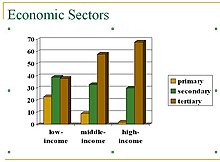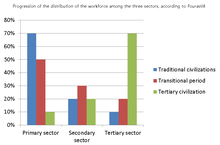经济部门



- 第一产业:涉及原料和生产,例如玉米、煤炭、木材和铁矿开采。(煤矿工人、农民或渔民是第一产业工人。)
- 第二產業:涉及将原材料或中间材料转变为商品,例如将钢铁制造成汽车,或将纺织品制造成服装。(建筑工人和裁缝属于第二产业工人。)
- 第三产业:涉及向消费者和企业提供服务,例如育婴、电影业和银行业。(店主和会计师是第三产业的工人。)
到了20世纪,经济学家开始认为,传统的三级服务可以进一步区分出“第四产业”和“第五產業”的服务业部门。第四产业部门的经济活动包括基于信息和知识的服务,而第三产业服务包括人类服务和招待性行业相关的产业。[2]
历史演变
一个经济体可能包括几个连续阶段发展起来的部门(也称为“产业”):
- 传统经济主要建立在自給農業基础上。
- 工业革命降低了自给农业的作用,在过去三个世纪中将土地利用转变为更粗放的單一耕作农业形式。经济增长主要发生在采矿、建筑和制造业中。
- 在现代消费者社会的经济中,服务、金融和技术(知識經濟)扮演着越来越重要的角色。
与发达国家相比,即使在近代,发展中国家仍更倾向于依赖前两个部门。
按所有权
经济也可以按照不同的所有权划分:
参见
参考文献
- ^ Zoltan Kenessey. The Primary, Secondary, Tertiary and Quaternary Sectors of the Economy (PDF). The Review of Income and Wealth. [20 April 2012]. (原始内容存档 (PDF)于2012-03-11).
Regarding the terminology itself Clark informs that "the term tertiary industries was originated by Professor A. G. B. Fisher in New Zealand, and became widely known through the publication of his book, The Clash of Progress and Security, in 1935. It took its origin from the titles current in Australia and New Zealand of 'primary industry' for agriculture, grazing, trapping, forestry, fishing and mining, and 'secondary industry' for manufacture. In Australia and New Zealand these terms are not only used in statistical reference books but are widely current in popular discussion. The phrase 'tertiary industries' therefore immediately carries, in these countries, a suggestion of those excluded by the official definition of 'secondary industries."
- ^ Matt Rosenberg. Sectors of the Economy. About.com. 14 January 2007 [20 April 2012]. (原始内容存档于2016-11-19).